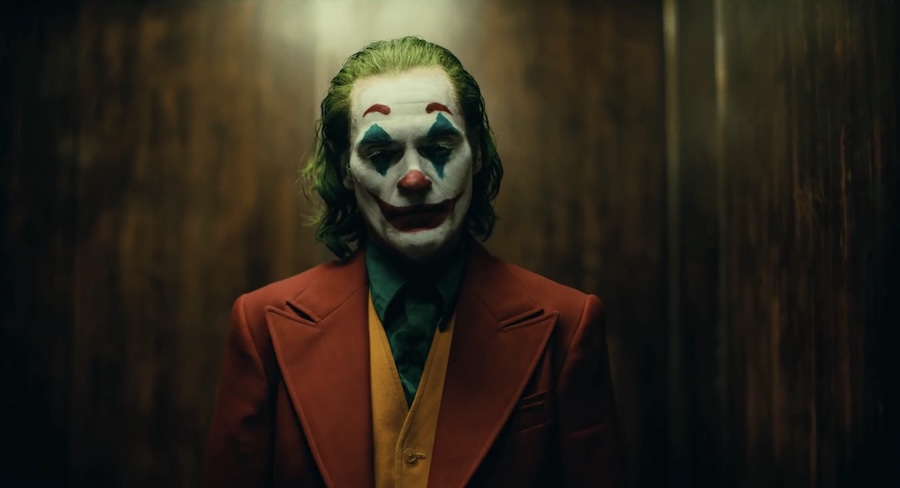
PUT ON A HAPPY FACE.

As it is about to premiere, Joker has become a controversial film. For the Twitter crowd, director Todd Phillips’s explanation why he decided to make the intensely dark and violent movie after a career of lighthearted bro comedies, is infuriating. In an interview with Vanity Fair, Phillips blamed woke culture for killing comedies, essentially saying that no one dares to be funny anymore because jokes might be judged offensive.
He’s obviously wrong, since there’s no shortage of good comedy these days. But considering the fury of some replies, he’s still hitting a nerve, and he’s not the only one making that argument. Cultural wars simmer in the background of Joker.
Suffering from emotional incontinence
In the early 1980s, we are introduced to Arthur Fleck (Joaquin Phoenix), a miserable young man who lives together with his mom (Frances Conroy) in Gotham City. Arthur, who’s been in a mental hospital, is still seeing a social worker as a condition to get his medication. Arthur suffers from emotional incontinence, causing him to laugh hysterically whenever he’s under pressure. He’s working as a clown-for-hire, but dreams of being a standup comedian, admiring the work of late-night TV host Murray Franklin (Robert De Niro). However, Arthur’s social skills are poor and he’s constantly harassed by co-workers and kids on the street where he’s working. After an incident, he’s fired and that’s the beginning of his next chapter in life – as the icon of a burgeoning protest movement.
Inspired by Scorsese
Phillips was clearly inspired by the 1970s and Martin Scorsese movies as he embarked on the most furious project of his career – Joker is full of references to Taxi Driver (1976) and The King of Comedy (1983), thematically and visually. Right from the start, there’s an old-fashioned Warner logo and Lawrence Sher’s cinematography makes Gotham look like New York before the city became a cleaner, more family-friendly place. Phillips and his co-writer Scott Silver envision the Joker before he became the legendary Batman villain as a Travis Bickle/Rupert Pupkin type, a lonely man who’s prone to violence and observes the world around him with disdain.
It’s also obvious that the film stirs something within us and makes us wonder if we see Arthur as a hero or villain.
Labeling Joker a dangerous film that will inspire young incels to go out and kill people, an argument some have made on Twitter, reinforces the false notion that movies and games cause violence and should be controlled to a greater extent than weapons. But it’s also obvious that the film stirs something within us and makes us wonder if we see Arthur as a hero or villain; certain engaging scenes where he’s transforming into the Joker look exhilarating, almost celebratory. In this film, full of victims, the Joker becomes a murderous symbol of both a popular uprising and our moral decay. It’s not something to admire. Instead, the story serves as a warning sign of what we as a society should look out for and try to treat.
As a standalone DC Comics movie, Joker really doesn’t have anything fresh to say about the Batman mythology, even if those references are fun for fans; we know the ingredients well. But towering above all this is Phoenix’s brutally tortured performance as a scarier clown than anything Pennywise can throw at us.
Joker 2019-U.S. 121 min. Color. Directed by Todd Phillips. Screenplay: Todd Phillips, Scott Silver. Cinematography: Lawrence Sher. Music: Hildur Gudnadóttir. Cast: Joaquin Phoenix (Arthur Fleck/Joker), Robert De Niro (Murray Franklin), Zazie Beetz (Sophie Dumond), Frances Conroy, Brett Cullen, Glenn Fleshler… Brian Tyree Henry. Cameo: Justin Theroux.
Trivia: Co-produced by Phillips and Bradley Cooper. Alec Baldwin was first cast as Thomas Wayne, but had to drop out. Followed by Joker: Folie à Deux (2024).
Oscars: Best Actor (Phoenix), Original Score. Golden Globes: Best Actor (Phoenix), Original Score. BAFTA: Best Actor (Phoenix), Original Score, Casting. Venice: Golden Lion, Best Soundtrack.
Last word: “The movie, in every way, tries to be grounded in reality as much as possible. It still has a foot in the comic book world, for sure, but we just kept thinking ‘Let’s put everything through a realistic lens.’ Like why does he have a white face? Well, [are we] going to drop him in acid?… While it’s amazing in the comic books and Jack Nicholson and all that, it doesn’t feel very real that that would happen if you fell into a vat of acid. So let’s come up with a realistic answer for everything.” (Phillips, Gizmodo)
